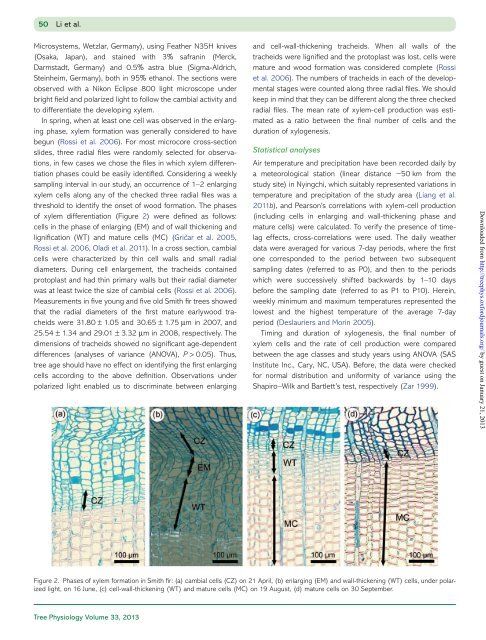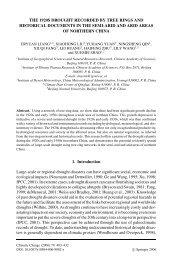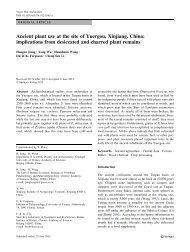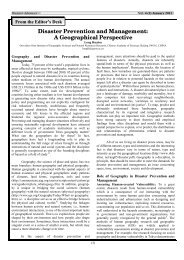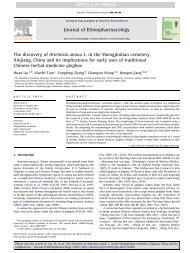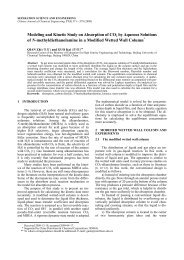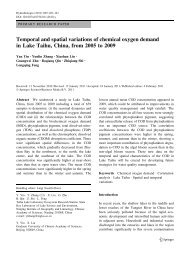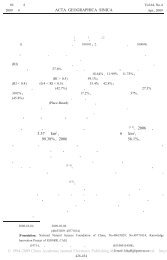AN INTERNATIONAL BOTANICAL JOURNAL
AN INTERNATIONAL BOTANICAL JOURNAL
AN INTERNATIONAL BOTANICAL JOURNAL
You also want an ePaper? Increase the reach of your titles
YUMPU automatically turns print PDFs into web optimized ePapers that Google loves.
50 Li et al.<br />
Microsystems, Wetzlar, Germany), using Feather N35H knives<br />
(Osaka, Japan), and stained with 3% safranin (Merck,<br />
Darmstadt, Germany) and 0.5% astra blue (Sigma-Aldrich,<br />
Steinheim, Germany), both in 95% ethanol. The sections were<br />
observed with a Nikon Eclipse 800 light microscope under<br />
bright field and polarized light to follow the cambial activity and<br />
to differentiate the developing xylem.<br />
In spring, when at least one cell was observed in the enlarging<br />
phase, xylem formation was generally considered to have<br />
begun (Rossi et al. 2006). For most microcore cross-section<br />
slides, three radial files were randomly selected for observations,<br />
in few cases we chose the files in which xylem differentiation<br />
phases could be easily identified. Considering a weekly<br />
sampling interval in our study, an occurrence of 1–2 enlarging<br />
xylem cells along any of the checked three radial files was a<br />
threshold to identify the onset of wood formation. The phases<br />
of xylem differentiation (Figure 2) were defined as follows:<br />
cells in the phase of enlarging (EM) and of wall thickening and<br />
lignification (WT) and mature cells (MC) (Gričar et al. 2005,<br />
Rossi et al. 2006, Oladi et al. 2011). In a cross section, cambial<br />
cells were characterized by thin cell walls and small radial<br />
diameters. During cell enlargement, the tracheids contained<br />
protoplast and had thin primary walls but their radial diameter<br />
was at least twice the size of cambial cells (Rossi et al. 2006).<br />
Measurements in five young and five old Smith fir trees showed<br />
that the radial diameters of the first mature earlywood tracheids<br />
were 31.80 ± 1.05 and 30.65 ± 1.75 µm in 2007, and<br />
25.54 ± 1.34 and 29.01 ± 3.32 µm in 2008, respectively. The<br />
dimensions of tracheids showed no significant age-dependent<br />
differences (analyses of variance (<strong>AN</strong>OVA), P > 0.05). Thus,<br />
tree age should have no effect on identifying the first enlarging<br />
cells according to the above definition. Observations under<br />
polarized light enabled us to discriminate between enlarging<br />
and cell-wall-thickening tracheids. When all walls of the<br />
tracheids were lignified and the protoplast was lost, cells were<br />
mature and wood formation was considered complete (Rossi<br />
et al. 2006). The numbers of tracheids in each of the developmental<br />
stages were counted along three radial files. We should<br />
keep in mind that they can be different along the three checked<br />
radial files. The mean rate of xylem-cell production was estimated<br />
as a ratio between the final number of cells and the<br />
duration of xylogenesis.<br />
Statistical analyses<br />
Air temperature and precipitation have been recorded daily by<br />
a meteorological station (linear distance ~50 km from the<br />
study site) in Nyingchi, which suitably represented variations in<br />
temperature and precipitation of the study area (Liang et al.<br />
2011b), and Pearson’s correlations with xylem-cell production<br />
(including cells in enlarging and wall-thickening phase and<br />
mature cells) were calculated. To verify the presence of timelag<br />
effects, cross-correlations were used. The daily weather<br />
data were averaged for various 7-day periods, where the first<br />
one corresponded to the period between two subsequent<br />
sampling dates (referred to as P0), and then to the periods<br />
which were successively shifted backwards by 1–10 days<br />
before the sampling date (referred to as P1 to P10). Herein,<br />
weekly minimum and maximum temperatures represented the<br />
lowest and the highest temperature of the average 7-day<br />
period (Deslauriers and Morin 2005).<br />
Timing and duration of xylogenesis, the final number of<br />
xylem cells and the rate of cell production were compared<br />
between the age classes and study years using <strong>AN</strong>OVA (SAS<br />
Institute Inc., Cary, NC, USA). Before, the data were checked<br />
for normal distribution and uniformity of variance using the<br />
Shapiro–Wilk and Bartlett’s test, respectively (Zar 1999).<br />
Downloaded from http://treephys.oxfordjournals.org/ by guest on January 21, 2013<br />
Figure 2. Phases of xylem formation in Smith fir: (a) cambial cells (CZ) on 21 April, (b) enlarging (EM) and wall-thickening (WT) cells, under polarized<br />
light, on 16 June, (c) cell-wall-thickening (WT) and mature cells (MC) on 19 August, (d) mature cells on 30 September.<br />
Tree Physiology Volume 33, 2013


